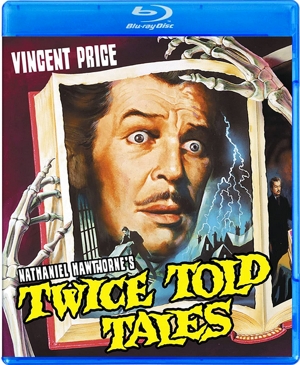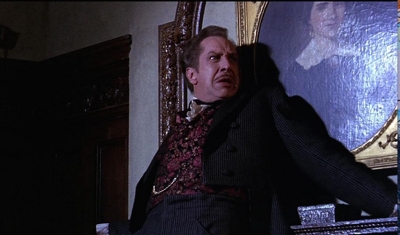Grade: B-/C+
Drama/Horror
Not Rated (would be PG)
Rewatching Twice Told Tales on the new Kino Lorber Blu-ray, I found myself wondering about the ideal audience for this film adaptation of Nathaniel Hawthorne stories featuring screen legend Vincent Price.
Children old enough to have read the stories in school might be curious to see how the 1963 film treatment was handled, but I’m not sure that they will appreciate a tone that tends toward the melodramatic. Director Sidney Salkow took a break from directing popular TV series like Death Valley Days to churn out seven B-movie genre films: four westerns, a mystery, and two fantasies—one of them being this anthology of Hawthorne tales.
Whether by design or coincidence, the three stories are presented in descending order of appeal. The strongest tale, “Dr. Heidegger’s Experiment,” is a short story that plumbs the depths of human desire for a fountain of youth or immortality. Like the frequently anthologized Edgar Allan Poe story “The Cask of Amontillado,” it involves a friendship that’s solid on the surface but bubbling beneath with hidden emotions. Sebastian Cabot—whose voice children may recognize as the narrator of Disney’s Winnie the Pooh films and the character Bagheera in Disney’s animated Jungle Book—plays Carl Heidegger, who celebrates his 79th birthday with best friend Alex (Price), his only companion since his beloved fiancée Sylvia (Mari Blanchard) died the night before they were to be married 38 years ago. But a “dark and stormy night” causes the door to a crypt in the backyard where her coffin is housed (yep, we’re talking Gothic romance) to open. Carl feels compelled to check on her, and both men are shocked to see that her body appears as it did when she was alive. The rest of the tale follows Dr. Heidegger’s drive to discover what preserved her and maybe even bring her back to life.
The type of horror included in these Price Told Tales is the same sort one would find in a Jaycee’s haunted house: skeletons, dead bodies, creatures dying instantly as if from witchcraft, blood oozing from strange places, etc.—minus the jump scares. It’s pretty tame but still somehow memorable . . . because of the images or concepts, or because of their pairing with old-time melodrama?
A second tale, the equally brief “Rappaccini’s Daughter,” riffs on the Rapunzel theme. Set in Padua, where Shakespeare’s The Taming of the Shrew took place, it features that old Shakespearian actor Price as Giacomo Rappaccini, a former professor. Rappaccini had become a recluse after his wife ran away with another man, leaving him to rear daughter Beatrice (Joyce Taylor) on his own. Fathers tend to be overly protective of their daughters as a matter of course, but the searing experience of his wife’s abandonment doubles the impulse. So of course he creates his own version of Rapunzel’s tower: a garden walled off from the outside world that houses her . . . and an exotic, highly poisonous plant. Call it a perverse Garden of Eden, and whatever Rappaccini used to teach, it included knowledge of science. Enter a university student named Giovanni (Brett Halsey), who sees Beatrice from an adjacent apartment window and falls instantly in love with her. No spoilers, but what happens next is the stuff of Shakespeare. A little bubble bubble here, a little toil and trouble there . . . .
The third tale features Price as Gerald Pyncheon, who, after a long absence, returns to his family’s house with his wife, Alice (Beverly Garland), much to the chagrin of his sister (Jacqueline deWit as Hannah). She brings Alice (and the audience) up to speed by explaining a curse put on the Pyncheon men by the former owner, who was cheated out of the house by one of the Pyncheons. But Gerald doesn’t care. He returned just so he could find the vault where property deeds are stored so he can increase his wealth. More graves, more digging, and more skeletons.
The House of the Seven Gables, is the longest . . . but also perhaps the least inventive and in this compressed version a bit too similar to Poe’s “The Fall of the House of Usher,” which was published 11 years later. Hawthorne wrote it as a Gothic novel, and in Gothic fashion it involves a gloomy and isolated old haunted mansion, a prickly resident, and a legacy of witchcraft dating back to the Salem years. Simplified and abbreviated for the big screen, it’s not nearly as effective and doesn’t make as much sense as Hawthorne’s original novel. I can hear him screaming from his own crypt, “Don’t judge me by this film version!!” I exaggerate. Hawthorne’s remains lie in simple grave in Sleepy Hollow Cemetery in Concord, Massachussetts.
Curiously, neither “Rappaccinii’s Daughter” nor The House of the Seven Gables were published in Twice Told Tales. The former was published as one of the stories in Mosses from an Old Manse, and the latter as a standalone novel. And frankly, the filmmakers ought to have chosen another story to feature rather than the sprawling novel, because it just doesn’t work in shorthand.
Back in the sixties, when this film was made, B movies were popular with studios because their low budgets (under $300,000) and quick turnaround (this one took two months from beginning to final print). Audiences liked them for the simple reason that they were “extras”—a bonus film shown in tandem with a more expensive, star-studded, heavily advertised A movie that followed. You knew that the B movies weren’t going to be great, but you hoped they would be more entertaining than cringe-worthy, as Twice Told Tales was.
When I interviewed Vincent Price decades ago, he said that “the best of those movies that I did were the ones that made fun of themselves.” The best of those films, in descending order, were The Pit and the Pendulum (1961), The Masque of the Red Death (1964), House of Usher (1960), Tales of Terror (1962), The Haunted Palace (1963), and Twice Told Tales (1963). Salkow was a bit too respectful toward Hawthorne to have any fun at the great American author’s expense, but the first two tales are entertaining despite the tone.
As to what audience? Those who like this film will probably include fans of Price, B movies, and sixties “horror”; people who aren’t bothered by melodrama (or find it fun to watch and mock); and children young enough to appreciate the special effects in Jaycees haunted houses and maybe even think them scary—but are old enough to know everything is all meant to be entertaining and nothing more.
Entire family: No (3rd grade and older?)
Run time: 120 min. Color
Aspect ratio: 1.66:1
Featured audio: DTS 2.0
Studio/Distributor: MGM/Kino Lorber
Bonus features: C+ (includes some fun Trailers from Hell)
Amazon link
Trailer
Not rated (would be PG for images of skeletons, corpses, and such, plus some adult themes and situations)
Language: 1/10—I didn’t catch anything, but that doesn’t mean there’s nothing here; it only means that the language didn’t stand out
Sex: 2/10—Some embraces and several allusions or references to affairs
Violence: 4/10—Characters are threatened by supernatural forces, characters fight, but the blood shown is not shown being produced on humans; the worst is probably a skeleton strangling a human in one-armed fashion that seem a bit hokey
Adult situations: 3/10—Casual/social drinking, and adult themes (greed, lust, etc.)
Takeaway: Those first two stories still play well if you can accept Price’s attempts to be semi-campy in a film that doesn’t seem to be pulling in the same direction






Leave a comment